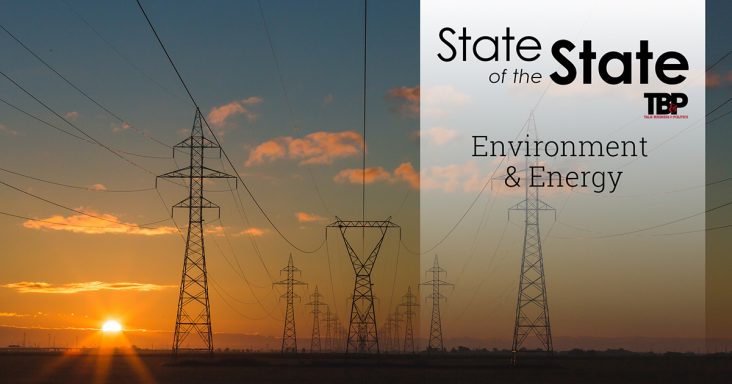State of the State Mid-Year 2023: Energy officials highlight positive outlook, price stability
by August 8, 2023 3:08 pm 703 views

Editor’s note: The State of the State series provides reports twice a year on Arkansas’ key economic sectors. The series publishes stories to begin a year and stories in July/August to provide a broad mid-year update on the state’s economy. Link here for the State of the State page and previous stories.
The Arkansas energy industry has many opportunities in which it can take advantage, including lowering costs and managing carbon emissions. Lauren Waldrip, executive director of the Arkansas Advanced Energy Association, is optimistic about the outlook.
“We’re seeing growth across the board, from an economic standpoint, from a demand standpoint, from a labor needs and development standpoint,” said Waldrip, noting the workforce in multiple sector segments, including energy efficiency, is expected to rise by 8% over the next year.
She expects federal resources available for energy efficiency projects to “bolster economic activity that will ultimately help Arkansans save money.”
According to an Energy Innovation report, clean energy tax credits in the Inflation Reduction Act are projected to boost clean energy deployment and electric vehicle sales in Arkansas. The investments would increase the state’s GDP by $1.9 billion in 2030. Arkansas is expected to gain more than 17,000 jobs in industries, such as manufacturing, construction and sales in 2030. By 2050, energy costs are projected to fall by a cumulative $1.4 billion across all Arkansas households, and more than 140 early deaths from pollution are expected to be prevented.

“We are uniquely positioned for a number of different reasons,” said Waldrip, adding that some of the federal resources require that the manufacturing inputs are procured in the United States, and steel is required to produce many of the projects. “We know that Mississippi County is the largest steel-producing county in the nation. Arkansas also has a very strong manufacturing scene.”
Waldrip expects a lot of new solar array projects this year after state legislators approved a new law that extended grandfathering for net metering until Sept. 30, 2024.
Arkansas Advanced Energy Association data show solar capacity in Arkansas is projected to rise by 85% to 1,162.8 megawatts in 2023 from 629.7 megawatts in 2022. Utilities account for 417.4 megawatts of the growth. Still, residential growth is expected to reach a record of 64.9 megawatts, a figure that’s not projected to be exceeded until 2030. Between 2021 and 2022, solar capacity rose by 13% from 559.2 megawatts to 629.7 megawatts, according to the organization. The capacity increased by 72% from 2019 to 2020.
OIL PRICE STABILITY
Gifford Briggs, director of the gulf coast region for American Petroleum Institute, said the stability of energy prices in the first half of 2023 was a surprise. Stability had been uncommon since the onset of the COVID-19 pandemic.
Briggs expects the second half of the year to be about the same as the first half. He noted this could change dramatically based on geopolitical events, such as the Russian invasion of Ukraine, that have affected the industry. He said the demand for oil and natural gas continues to rise, and the industry will continue to work to meet the demand.

According to Baker Hughes, the number of active U.S. rigs was 669 as of July 21, down 89 from the same time last year. Briggs said the active rig count provides an industry snapshot and lags pricing. He said the industry isn’t seeing the level of leasing activity that it would like in the Gulf of Mexico, and said the administration has stalled on approval of a five-year lease sale plan. Having an approved plan in place is one of his top priorities this year. Leasing in the region would allow the industry to make investments there as it looks to meet U.S. energy demand.
“We have seen some positive steps for and around carbon capture and storage,” said Briggs, adding that the U.S. Environmental Protection Agency allowed Louisiana primacy for carbon capture of storage wells. “It’s important for Arkansans because the legislature passed legislation this year that would allow for the sequestration of captured carbon.”
He said the next step would be for Arkansas to consider primacy allowing the state to take over permitting for wells from the EPA. He said Arkansas has primacy over some wells, allowing for the injection of carbon into oil reservoirs to produce additional oil reserves. But the state could expand this and decide whether to use manufacturing plant emissions in other manufacturing processes, such as for asphalt, or store “them safely away from air or from water in deep, underground reservoirs,” said Briggs, noting the EPA must approve this currently and about 20 permits to do so have been pending for years.
“The goal is for each state to get primacy over these types of wells,” he added. “It has not happened in Arkansas yet, but as the energy industry continues to evolve – and focusing on maintaining (and) producing American energy and oil and natural gas while lowering emissions – carbon capture and storage is absolutely essential to meeting those goals.”
